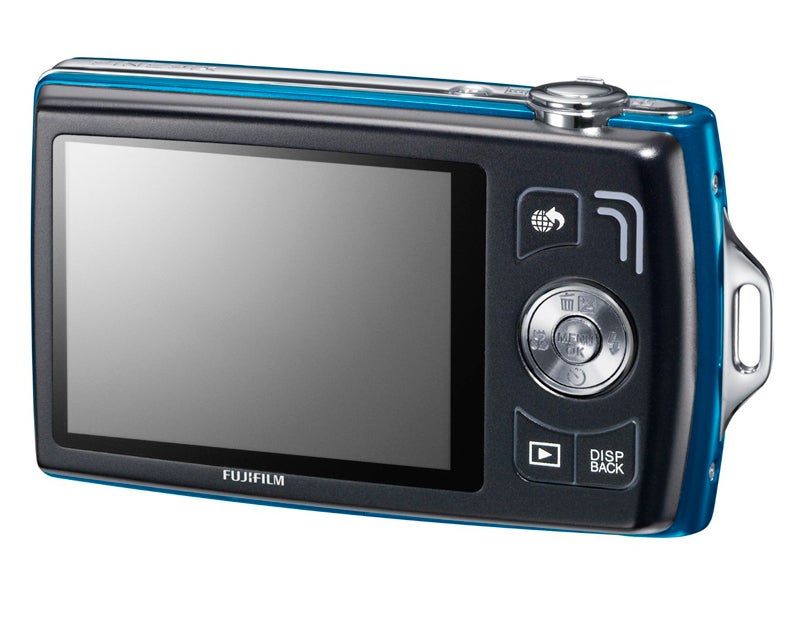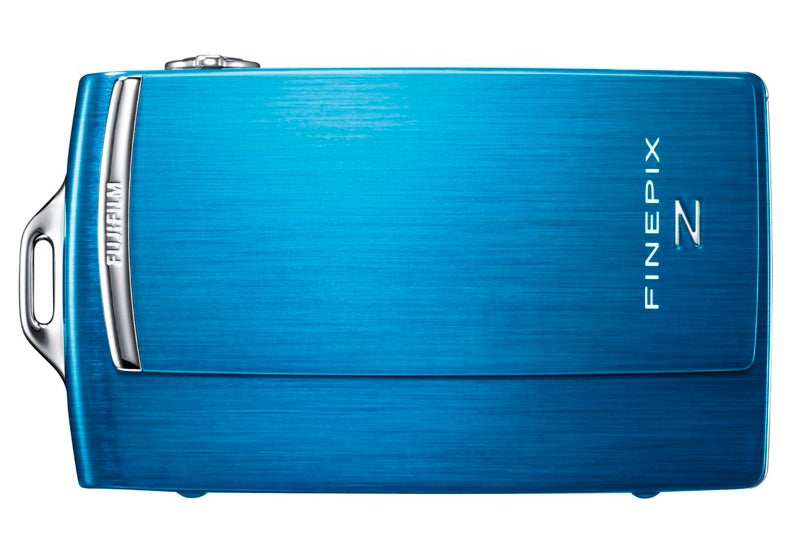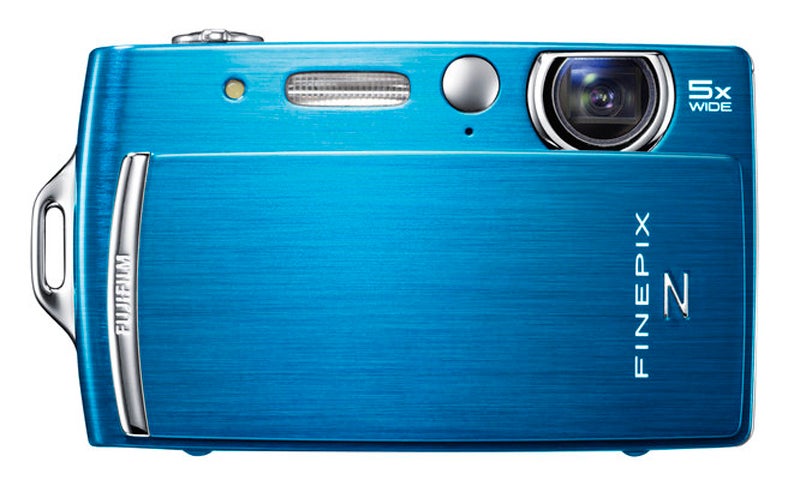Fujifilm FinePix Z110 Review
Fujifilm FinePix Z110 Review
Fuji’s latest sleek-looking ultra-compact digital camera is the FinePix Z110, a camera sitting within the company’s Fashion range. It may have sleek looks, but how does it shape up as a compact camera?

Verdict
Pros
- Styling; Build; Size; Ease of use; Price
Cons
- Battery life; Focusing; Display colour balance; No TV connection supplied in box; High ISO noise and detail smoothing
Key Specifications
- Review Price: £120
Fujifilm FinePix Z110 review – Features and Design
The Z110 combines an ultra-compact design and beautiful styling that is sure to turn the heads of those in the market for a pocketable, relatively inexpensive snapper. Built around a 14-megapixel CCD sensor the camera’s other key features include a 28-140mm 5x optical zoom lens with dedicated 720P HD video capability.
There’s a sophisticated contrast detection auto focus set up for such a (relatively) modest camera in that you have face detection AF, joined by central and tracking AF, single and continuous focusing.
The camera’s fixed 2.7in monitor has a 230k-dot resolution, so modest in terms of dot density but it’s okay to use in all but the brightest of conditions with its power save off, where it stays slightly brighter. However, the display’s colour balance is off appearing it’s warmer than the final images, which seems odd and while not a massive issue, it’s worth bearing in mind if the colours look a little off at first.

There’s a 29 MB of internal flash memory with external storage coming in the shape of SD/SDHC/SDXC media housed in a card slot alongside the NP-45A lithium-ion battery – a battery that’s good for a rather miserly 220 shots according to Fuji.
I found it proved much less than that however, with the battery warning first showing at around 120-shots, with only minimal flash use and reviewing of images, so something of a disappointment at that point. However, turning the flash off helps and I found it best to switch the camera out of it’s – otherwise effective – Auto SR (automatic scene recognition mode, which can detect six different scenes: Portrait, Backlit Portrait, Macro, Landscape, Night Portrait and Night scene) setting and into Program, which allows you to deactivate the flash and stops it from charging automatically each time you switch the camera on.
That and activating the various power saving features, such as lowering the LCD brightness (though that has its concomitant issues around viewing in brighter conditions) turning on the display’s power save mode (reduces the frame rate), turning off the (digital only, so no optical) Image Stabilisation and setting the auto-off timer to the minimum of two minutes, all help.
The camera has HD video capability but only with a maximum of the 720P variety with mono sound, but there’s no HDMI out port; there is a combined USB 2.0 port for power, charging and connectivity to, say a TV and computer, but the computer/power lead included in the box cannot connect the camera to a TV; the cable for that is a disappointing optional extra.

The camera comes in a variety of colours too; pink, purple, jade, blue, white and black. A set of modern blue backlit controls give the camera an air of exclusivity and looks attractive to boot; controls are simple enough to use as well.
A shutter button on the top is joined by a rather small direct video mode button, but because the camera’s front lens cover sliding panel is also the on/off button, there’s a tendency (at first) to press the video button thinking it’s the on/off button. Queue a short burst of unwanted video! Once you get used to that handling “foible” it’s a breeze to use.
The aforementioned back plate controls include a four-way jog button that can be used to activate the flash, exposure compensation, macro shooting and self timer modes, of which you get a nice array of options. There’s the usual 10-second setting, then a two-second timer, there’s then a neat couple’s timer, where it snaps only when two people get close together in front of the lens and you get a clever group timer that can be set to fire the shutter at a predetermined number of people, up to four.
Another plus is the all-metal camera body, even the sliding front panel is metal, so the camera’s 145g weight (with card and battery on board) still makes the camera feel substantial when hefted in the hand, but with its tiny 97 x 58 x 20mm dimensions, means you can literally pop this camera into the smallest of pockets.
Performance, Image Quality and Verdict
Fuji FinePix Z110 review – Performance and Image Quality
Even though the Z110 is small it provides a pleasing user experience – the shutter and video capture buttons are positioned well and the lens zoom control round the shutter release is okay to use too. Start up is on the slow side, accompanied by the usual beeps and warbles you’d expect and that can be switched off within the camera’s clear, easy to use menus.
Menus are in two tabbed backs – one for shooting and associated bits and pieces, one for deeper settings such as date and time set up, video mode selection (PAL or NTSC) and memory card formatting or power saving set up and adjustments. If in playback mode (and you can activate playback, with the camera off, by pressing the playback button on the back) you get a set of specific playback menu options (rather than the shooting settings) and the set up options.
In each case the menus are clear and easy to read. Some form of assistant or guide in menus might hep the typical user of this camera, but other than that once you’ve tinkered in the menus once it’s all simple enough to get to grips with.

With the front open and the camera on, the lens is unveiled and ready for action, next to it a small self-portrait mirror and then a tiny flash unit, good for only around 10-feet tops or as a most fill-in
In terms of shooting performance however, things can be less than straightforward. For a kick off, the screen’s colour balance is off; it’s too warm, which while not catastrophic does make it hard to assess the camera’s white balance settings. And despite the rather sophisticated set of focusing systems employed by the camera, focusing can be hit and miss, most noticeably in the Auto SR mode.
Auto SR works well at activating the right camera features for the subject (portraits for portraits and landscape mode for a landscape, for example) when it’s obvious however images can either lack sharpness – particularly at full zoom on more complex subjects- or simply not be properly focused at all. I found macro to be much more reliable than landscape for example.
The metering also struggled mightily with backlit scenes. The automatic backlight compensation has little chance as the fill-in flash puffed in vain with such a large expanse of shadow to contend with.
To help mitigate the metering problems, you do get exposure compensation to tune of +/-2EV, so there’s a little room to play with harder to meter subjects, although another way around problems is to use the camera’s various automated modes. Come out of Auto SR and choose one of the 19 dedicated scene modes that range from Cat and Dog settings to shooting Portrait or Night Scene modes. Depending on the setting (and yes, an element of trial and error is needed) this helps bias the light measurement accordingly in order to help get a better balance on some scenes.
The camera’s sensitivity range runs from ISO 100 to 3200. Left in ISO AUTO mode the camera sorts itself out well and noise is surprisingly limited, but it’s visible over ISO 400 visible with a loss of detail at ISO 800 and above here, while noise is an issue, the drop off in detail is worse.
Colour capture is rather good, though you can use a variety of settings. Black and white, Chrome (that mimics Fuji’s colour slide film emulsions), Standard and Sepia being the main options via the “FinePix Color” menu option, available when outside the camera’s automated shooting settings, so from within Program mode.
Another funky feature is the ability to upload images and video you shoot to Facebook or YouTube, selected from within the camera but only completed when you plug the camera into your (Windows only) computer and via the MyFinePixStudio software that comes on the camera’s supplied software CD.
Overall though, given the price and the kit available, the Z110 does a great job. Despite the display’s odd bias towards warmth colour capture in the shots is okay, and it’s always nice to have colour and mono options to hand if you fancy getting a little more creative. It isn’t without issues – the camera’s struggle with backlit subjects is one, the focusing is too hit and miss and while not overly sluggish, the camera is not the fastest out of the blocks.
Fuji FinePix Z110 review – Verdict
Overall, the Fujifilm FinePix Z110 is a stylish and easy to use camera, one that can produce nice results given the right circumstances – the softness of some shots and the detail leaching in higher sensitivity settings can be problematic but only if you try to blow the images you take up to a large size. The focusing is my biggest worry, and while on general subjects or when using the central AF point on its own (in Program mode) it seems better, it’s just a shame you don’t always know when it’ll do it’s best work in the automated modes.
Trusted Score
Score in detail
-
Value 10
-
Design 9
-
Features 9
-
Image Quality 8
-
Performance 8


